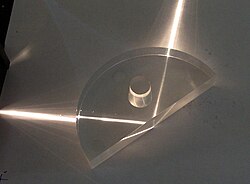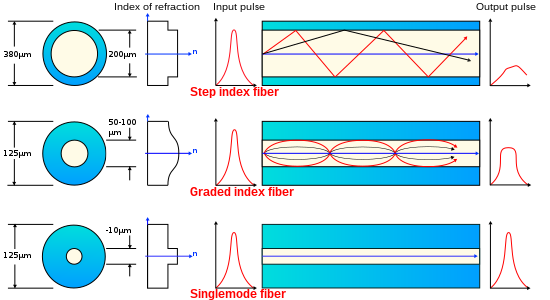Materials Science and Engineering/Doctoral review questions/Daily Discussion Topics/01112008
Total Internal Reflection
[edit | edit source]
Total internal reflection is an optical phenomenon that occurs when a ray of light strikes a medium boundary at an angle larger than the critical angle with respect to the normal to the surface. If the refractive index is lower on the other side of the boundary no light can pass through, so effectively all of the light is reflected. The critical angle is the angle of incidence above which the total internal reflection occurs.
When light crosses a boundary between materials with different refractive indices, the light beam will be partially refracted at the boundary surface, and partially reflected. However, if the angle of incidence is greater (i.e. the ray is closer to being parallel to the boundary) than the critical angle — the angle of incidence at which light is refracted such that it travels along the boundary — then the light will stop crossing the boundary altogether and instead be totally reflected back internally. This can only occur where light travels from a medium with a higher refractive index to one with a lower refractive index. For example, it will occur when passing from glass to air, but not when passing from air to glass.

Total internal reflection can be demonstrated using a semi-circular glass block. A "ray box" shines a narrow beam of light (a "ray") onto the glass. The semi-circular shape ensures that a ray pointing towards the center of the flat face will hit the curved surface at a right angle, thus preventing refraction at the air/glass boundary of the curved surface. At the glass/air boundary of the flat surface, what happens will depend on the angle. Where θc is the critical angle:
- If θ < θc, as with the red ray in the above figure, the ray will split. Some of the ray will reflect off the boundary, and some will refract as it passes through.
- If θ > θc, as with the blue ray, all of the ray reflects from the boundary. None passes through.
Modes in Optical Fibers
[edit | edit source]
Optical fiber can be used as a medium for telecommunication and networking because it is flexible and can be bundled as cables. It is especially advantageous for long-distance communications, because light propagates through the fiber with little attenuation compared to electrical cables. This allows long distances to be spanned with few repeaters. Additionally, the light signals propagating in the fiber can be modulated at rates as high as 40 Gb/s, and each fiber can carry many independent channels, each by a different wavelength of light (wavelength-division multiplexing). Over short distances, such as networking within a building, fiber saves space in cable ducts because a single fiber can carry much more data than a single electrical cable. Fiber is also immune to electrical interference, which prevents cross-talk between signals in different cables and pickup of environmental noise. Also, wiretapping is more difficult compared to electrical connections, and there are concentric dual core fibers that are said to be tap-proof. Because they are non-electrical, fiber cables can bridge very high electrical potential differences and can be used in environments where explosive fumes are present, without danger of ignition.
Number of Modes
[edit | edit source]The number of modes in an optical fiber distinguishes multi-mode optical fiber from single-mode optical fiber. To determine the number of modes in a step-index fiber, the V number needs to be determined: where is the wavenumber, is the fiber's core radius, and and are the refractive indices of the core and cladding, respectively. Fiber with a V-parameter of less than 2.405 only supports the fundamental mode (a hybrid mode), and is therefore a single-mode fiber whereas fiber with a higher V-parameter has multiple modes.
Decomposition of field distributions into modes is useful because a large number of field amplitudes readings can be simplified into a much smaller number of mode amplitudes. Because these modes change over time according to a simple set of rules, it is also possible to anticipate future behavior of the field distribution. These simplifications of complex field distributions ease the signal processing requirements of fiber-optic communication systems.
Drude Model
[edit | edit source]The Drude model of electrical conduction was developed in the 1900s by Paul Drude to explain the transport properties of electrons in materials (especially metals). The Drude model is the application of kinetic theory to electrons in a solid. It assumes that the material contains immobile positive ions and an "electron gas" of classical, non-interacting electrons of density n, each of whose motion is damped by a frictional force due to collisions of the electrons with the ions, characterized by a relaxation time τ.
Explanation
[edit | edit source]The Drude model assumes that an average charge carrier experiences a `drag-coefficient' . Under an applied electric field E this leads to the following differential equation:
where denotes average velocity, m the effective mass and q the charge of the charge carriers.
The steady state solution () of this differential equation is
where:
is the mean free time of a charge carrier, and is the mobility]]. Now, introducing charge carrier density n (particles per unit volume), we can relate average velocity to current density:
The material can now be shown to satisfy Ohm's Law with a DC-conductivity .
The Drude model can also predict the current as a response to a time-dependent electric field with an angular frequency , in which case
Here it is assumed that
In other conventions, is replaced by in all equations. The imaginary part indicates that the current lags behind the electrical field, which happens because the electrons need roughly a time to accelerate in response to a change in the electrical field. Here the Drude model is applied to electrons; it can be applied both to electrons and holes; i.e., positive charge carriers in semiconductors.
Inadequacies of model
[edit | edit source]This simple classical model provides a very good explanation of DC and AC conductivity in metals, the Hall effect, and thermal conductivity (due to electrons) in metals, although it greatly overestimates the electronic heat capacities of metals. In reality, metals and insulators have roughly the same heat capacity at room temperature. Also, the Drude model fails to explain the existence of apparently positive charge carriers as demonstrated by the Hall effect.






















